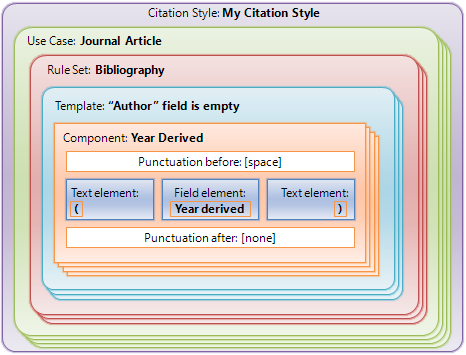Anatomy of a Citation Style |

|

|
Before you begin creating or editing a citation style, it's good to understand how a citation style is constructed.
A citation style is a complete set of rules and formatting covering the entire range of applications of the style. Citavi represents citation styles as a hierarchical nesting of parts.

The highest level inside a style is the use case, which is the specific reference type (for example, a book) or combination of reference types (for example, a contribution in an edited book).
Each use case consists of three rule sets: in-text citation, footnote citation, and the entry in the bibliography. A rule set can also be inherited from another use case, so you can save time by reusing rule sets.
Within each rule set, there are one or more templates, which define the citation or bibliography entry. In many citation styles, citations are formatted differently depending on the citations around them. Templates handle these conditions: one template is the default template, and conditional templates placed before it "catch" special cases.
Within each template, components insert content with its formatting and punctuation. Components are reusable within a citation style, but it is critical to understand that every instance of a component is identical — if you edit a component in one place, every other instance of it will change as well. If you need the same component in different templates, but with different formatting, you must make a separate component for the alternative formatting.
Within each component, elements are the basic building blocks of content: static text and the contents of fields.
When a citation style is applied to a citation, first the use case is determined, then the appropriate rule set, then the conditions of each template are evaluated (the first one that matches is applied, otherwise the default template is used). Once the correct template is determined, the components pull the contents from the citation and the static text, apply formatting, and output the formatted citation to your publication or bibliography.
URL for this page:
http://manual.citavi.com/en/?citation_style_anatomy.htm (Last updated: 18.08.2011 15:10:58)
Still have questions? Please visit our Service Portal where you can search our Knowledge Base and send questions to the Citavi team.